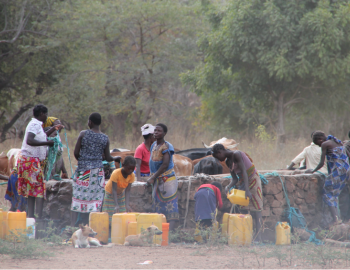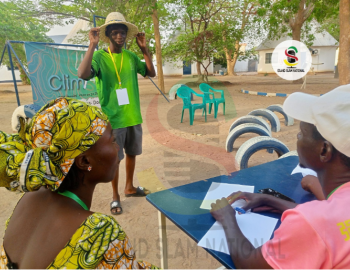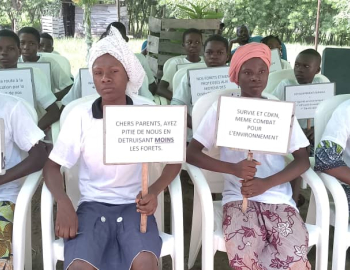Reflecting as we go: Lessons from CDKN’s open call for locally-led adaptation initiatives in Africa
Reflecting as we go: Lessons from CDKN’s open call for locally-led adaptation initiatives in Africa
As part of its commitment to mobilising climate knowledge for climate-resilient action, CDKN is providing Knowledge-to-Action (K2A) grants in Africa, Asia and Latin America. In Africa, an open call for locally-led adaptation (LLA) initiatives and a comprehensive selection process led to five K2A projects being chosen to receive US$150,000 each in Benin, Cameroon, Kenya, Mozambique and South Sudan. Providing grants to support LLA is new terrain for the CDKN programme, and we intentionally adopted a learning approach. Here we share our insights from the selection process.
The concept of locally-led adaptation (LLA) as a means to implement climate adaptation that responds to the lived realities and needs of local communities is growing in prominence across the world. At the forefront of thinking around LLA, the Global Commission on Adaptation developed eight guiding principles, which have been endorsed by over 120 different organisations, including local governments, non-governmental organisations (NGOs) and global institutions. However, while these principles reflect a transformative approach by the development community towards supporting climate adaptation, many organisations are still figuring out how to effectively put them into practice.
This was raised at the 18th International Conference on Community-Based Adaptation (CBA18) in May 2024, where there was a demand for evaluating different approaches to LLA and a request to reform funding mechanisms to make resources more accessible to local actors. During its third phase, CDKN has been supporting the flow of climate finance to the local level by designing a funding mechanism that focuses on supporting community-based organisations (CBOs).
In March 2023, CDKN launched a call for concepts that support LLA initiatives in Africa. Before launching this new phase of work, we held discussions with grant-makers who had already been disbursing funding at the local level, including the Global Center on Adaptation (GCA), Slum Dwellers International (SDI) Kenya, and the Small-Grants Facility (SGF) to learn from their experiences.
A year and a half later, we have partnered with five organisations leading local adaptation initiatives in five countries across Africa. This is the story of how we got there.
Designing an accessible approach
From the outset we designed an accessible, two-tier approach, putting out an open call for concepts followed by an invitation for the top 11 applicants to submit proposals.
We launched the call in two languages that are widely used across Africa: French and English. Producing our call documents and webinars in two languages and reviewing all the concept notes was a challenge for us, since our English-speaking team only had two fluent French speakers. While artificial intelligence translation tools such as DeepL helped, some of the technical terms meant that the documents needed to be verified by our French-speaking team.
To improve accessibility, we wanted to avoid burdening the applicants with a long and detailed proposal, when the competition might be high and the likelihood of success low. We heard many examples of calls that exclude smaller, less-established organisations in favour of ‘the usual suspects’ because the latter are better able to produce the required documentation, financial records or professional history.
Our call was intentionally designed to reach local organisations that might otherwise struggle to obtain funding for their adaptation initiatives. We did not ask applicants to provide supporting documents that are typically requested by a call (e.g. registration certificates, adaptation rationale), nor did we ask lead organisations to provide financial statements. We circulated our call through social media channels and directly emailed over 100 organisations using the CDKN network. The details were shared widely on WhatsApp groups and we found it posted on other funding websites (not always with correct details). It gained traction among NGOs, and our inbox became flooded with questions. In all, this meant we received over 1000 concept applications from 45 African countries.
Choosing key criteria for applications
We chose indicators that would enable us to reach organisations that we have not worked with before, specifically aiming at NGOs and CBOs who work at the grassroots level. For example, the lead organisation(s) had to be based in Africa, with one partner or more present in the locality where the project would be. The proposals needed to incorporate a substantial gender and social inclusion (GESI) element, and they needed to describe how decision-making power would be given to the local households, groups, organisations and communities to define, prioritise, design, implement, monitor and evaluate the initiative.
One fundamental criterion we used to assess the proposals was to focus on how locally-led they were. We used the global principles on LLA and our discussions with local organisations to guide us. However, we reflected that the principles, while relevant to grant-makers and non-local intermediaries, are less relevant to local organisations and programmes like ours, who are working to define what LLA looks like on the ground and what is needed to enable it. We often asked ourselves how could we tell if a project was truly locally-led, or managed by another intermediary, far-removed from the priorities of local people?
The majority of applications were submitted by NGOs, demonstrating how intermediaries persist at local level - although most applications did come from local NGOs, with only a few from international NGOs. We debated whether we should be funding NGOs at all, or whether we should be targeting CBOs and grassroots organisations. However, we found that local NGOs, while not always community based, can be very responsive to communities’ needs, and can influence other national actors, which is often a key enabling factor for effective LLA.
After assessing hundreds of concepts, our team began to see some common characteristics of strong LLA projects emerge:
- A significant proportion of the budget and share of responsibility is allocated to local community partners (e.g. Micaia organisation in Mozambique works closely with Gonzololo, a youth-led, Portuguese-speaking, volunteer group who have been tasked with leading their school engagements and are responsible for one third of the budget).
- The lead organisation is based near where the project work occurs (at least in the closest city).
- The project proposal describes participatory methods of engagement and the co-development of ideas (e.g. Survie de la Mère et de l’Enfant in Benin established a project steering committee with representatives from local communities to guide their project activities).
- The priorities of local people are already well-defined and articulated in the proposal (e.g. Nature and People as One in Kenya had already identified issues of human-wildlife conflict raised by their SAKU community forestry association).
- Project participants are described as partners or rights holders.
- Feedback to project participants is integral in the project design (e.g. Grand Slam in Cameroon has a strong social media presence which allows them to share records of their performances).
- Project deliverables are predominantly useful to the project participants themselves, and not external actors (e.g. the mapping of flood risk vulnerability by our YEDA project in South Sudan helps to inform local people where is best to build and where to be cautious).
- The project team is made up of people who are part of the same ethnic group or community that is being supported.
Allowing time and resources for the review process
Open calls for funding are often well subscribed. The initial interest our call generated created high traffic to the CDKN website, and a webinar about the call was oversubscribed when 2,000 applicants signed up - we had to develop a last-minute YouTube channel to livestream the event and develop a K2A frequently asked questions form.
Over 60% of applications were received in the two days before the deadline and the eligibility rate was 95%, making the selection process necessarily time consuming for the team. Because of this, we adapted our initial review plan, which was designed to be staged, and all our reviewers became part of the concept review process. To help the core delivery team sift through concepts we brought in people from across CDKN and our partner organisations, so our team included a range of experience. For some, LLA was a new concept and with our evaluation criteria being quite broad, there were some major score discrepancies between reviewers. Moreover, without a full understanding of LLA, some reviewers gave high scores to well-articulated proposals that were quite top-down in their approach. To reduce any bias, we paired more experienced reviewers with less experienced reviewers.
Our core team then had a busy moderation stage, comparing reviews and comments to assess if any adjustments were needed. Having selected the top 30 concept notes, we asked experts to provide a third review and re-ranked the concepts. While the scores didn’t change much, their comments were valuable for seeing how a project that initially sounded excellent could be exclusionary for certain groups. We hosted an evaluation meeting to discuss the top 20 concepts in relation to our defined criteria and their alignment with our programme. We also discussed geographic diversity, diversity of approach and the reviewers’ comments, which proved valuable for understanding why certain scores were given. A shortlist of 11 was selected and applicants were invited to submit a full proposal.
Assessing follow-on proposals and interviewing shortlisted applicants
At the proposal stage, we asked for evidence of an established relationship with the project participants, such as signed letters of understanding or pictures of past engagements. We also asked them to describe how they considered local cultural and ecological issues in their projects to see how responsive and knowledgeable they were about their contexts and communities.
Furthermore, we asked for a description of ethical and safeguarding considerations and for applicants to indicate whether they could provide documentation that met our due diligence requirements. The latter was especially important for applicants from higher-risk countries who needed to provide an additional, although not arduous, risk mitigation strategy for them to be approved. Our ethical review team flagged some issues with a few proposals at this stage and two proposals were excluded. The subsequent interviews with the remaining applicants were a valuable part of the selection process, revealing the project teams’ passion for and understanding of their project contexts, and in two cases raising further flags. After a final evaluation we selected five initiatives.
On reflection
It took eight months from the date the open call was launched to the final selection of projects in October 2023. 47 different reviewers, both English and French speaking, reviewed up to 100 applications each. 11 longer proposals were submitted and considered by three to four reviewers each. Two panel discussions, one ethics review discussion, and seven interviews later we selected the top five projects. Given the significant time and resources that this process requires, including a full-time role dedicated to coordination, the benefits of an open call with broad criteria need to be weighed against the costs. Importantly, some learnings about the process emerged that we will take forwards into how we manage future calls.
We recognised how funding seems to flow to regions where funding flows already exist or where there is perceived good governance and perhaps an existing geopolitical bias. This partly explains the number of projects from countries in East Africa, especially Kenya, which has a well-established NGO sector that is already able to access other funds, and which submitted a diversity of applications.
We learnt that we need to make decisions early in the process about what type of projects we would consider. The CDKN K2A call deliberately adopted broad criteria so that organisations could frame a diversity of project proposals to suit the grant. We also designed it as an open call for innovative projects from across the continent. This resulted in a huge number of applications, and we had to reject and disappoint many applicants, some of whom were surprised that only five grants were being offered for an open call that spanned Africa.
Going forwards, one suggestion is to have targeted calls with clear criteria, for example, focused on certain countries. Specifically, we received fewer concepts from West and Central Africa, likely as a result of several factors, including historical funding flows, language and levels of global integration. This is a region where we have fewer networks and less experience, and we would need to design calls in French to make them accessible. Targeted calls would limit the number of applications but would make the evaluation processes simpler.
We raised the question of whether local organisations should even need to write their own funding proposals, during conversations on financing LLA at a CDKN-hosted community of practice. Should there be more responsibility placed on the grant-makers to identify effective and sustainable initiatives? Collaboration between grant-makers needs to come to the fore to allow smaller projects with good practice to be linked with larger funding organisations. This would mean they could bypass some of the due diligence requirements that currently limit them from accessing funding from larger organisations. Local organisations could then spend less time applying for funding, and more time working on follow-up activities, or scaling their work, to enable better long-term impact. This is a sustainability challenge that is not unique to LLA but is symptomatic of development funding in general.
Where next?
Of the five projects that CDKN has now partnered with, four are in countries we haven’t worked in before. Three of our partners could be described as grassroots organisations and the others work in close partnership with grassroots organisations.
Many of these organisations and projects rely on grant funding to carry out their day-to-day work but spend almost as much time applying for funding as they do implementing their work. In the future, potential grant-makers need to consider how their funding can be delivered in a structured, integrated manner, so as not to perpetuate chequered support for small scale, short-term projects. Smaller organisations, especially at the local and community level, face the challenge of receiving small grants, with small grant tenures, that allow them to make progress, only to have that progress slow once funding ends – a moment known as the funding cliff edge.
CDKN is designing a process that supports the K2A grantees in how to strategise and mobilise funding after the grant period has ended. To build the sustainability of the grantees work, the K2A grant programme seeks to support its grantees to access additional funding that can ensure the financial stability and long-term impact of the work currently being funded. It also aims to share valuable insights and learnings with donors, funders, intermediaries and support organisations who are seeking to finance LLA.
The process of launching an open call for concepts to support LLA initiatives was rigorous, time consuming and expensive. However, before launching the call we had little idea of what types of applications we would receive and how to assess whether they were truly accountable to local actors. Through the process the CDKN team gained an understanding of the number of organisations doing impactful work across Africa, what this work looks like at the local level and what the grantees need going forward.





